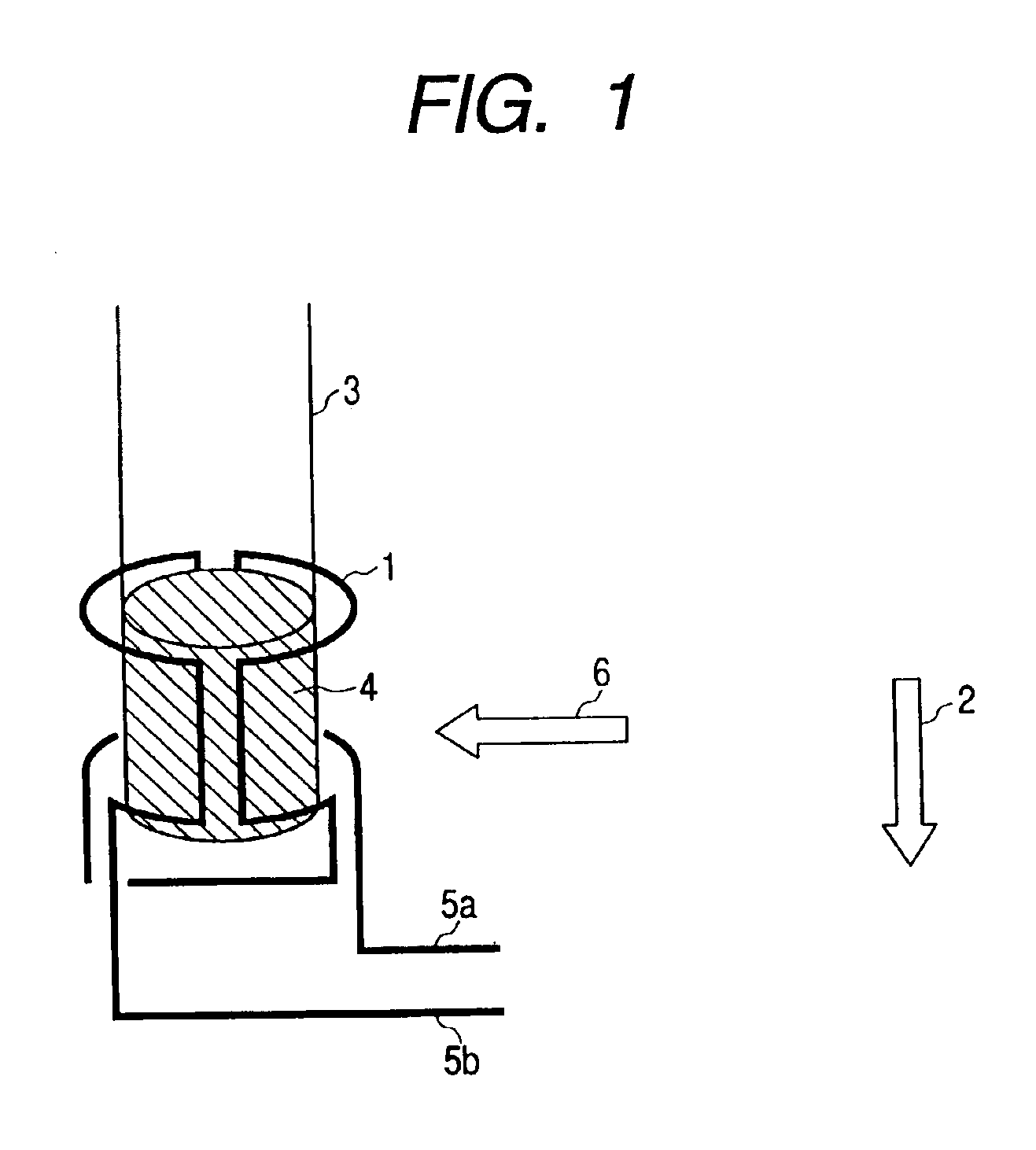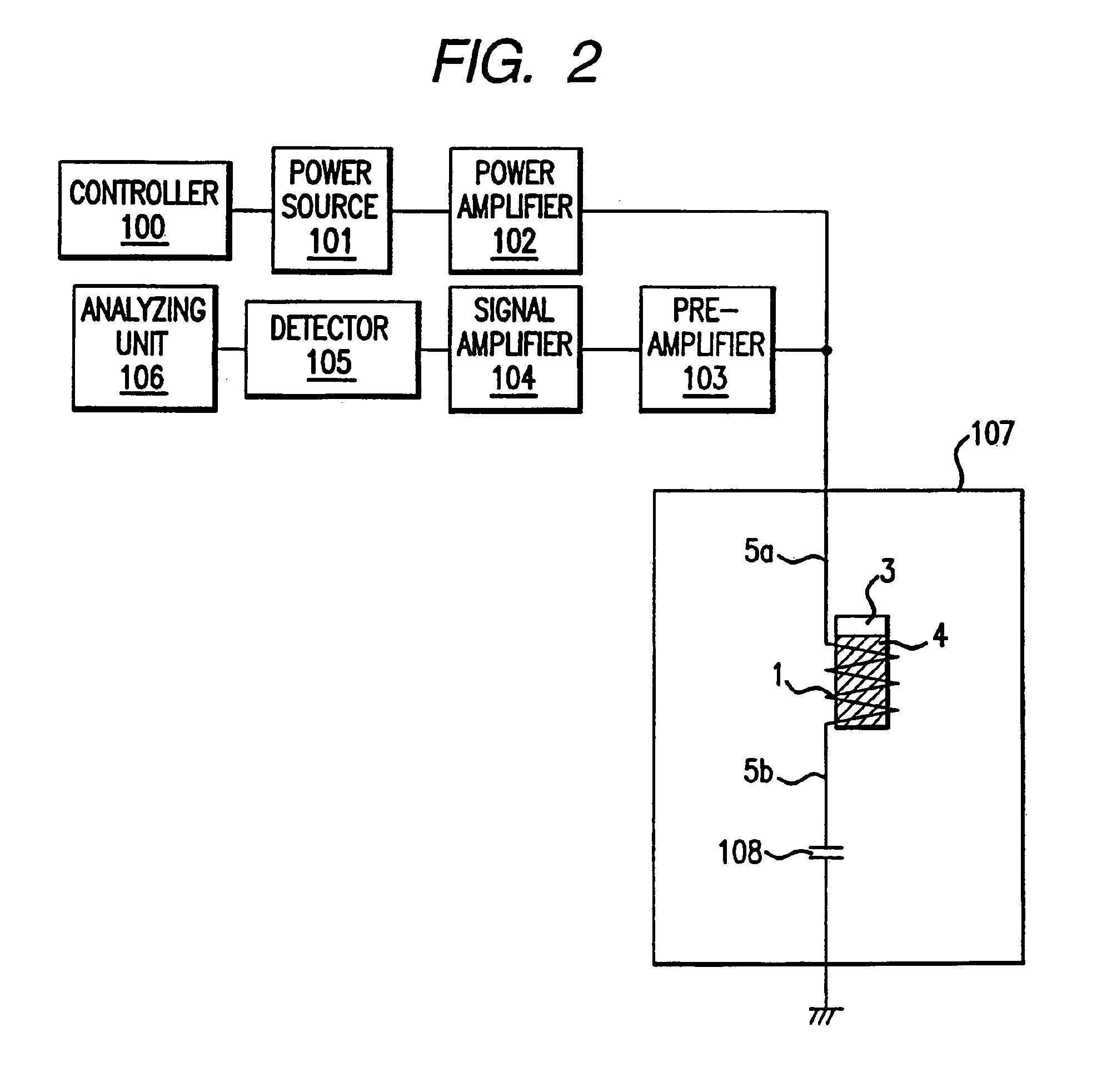Probe for NMR apparatus using magnesium diboride
a technology of magnesium diboride and probe coil, which is applied in the direction of superconducting magnets/coils, magnetic bodies, instruments, etc., can solve the problems of difficult shape formation of film conductors of ybco, difficult application to solenoid type probe coils, and difficult design of superconducting magnets. achieve the effect of improving q-factor and s/n ratio
- Summary
- Abstract
- Description
- Claims
- Application Information
AI Technical Summary
Benefits of technology
Problems solved by technology
Method used
Image
Examples
example 1
[0040]A saddle type probe coil for an NMR apparatus according to Example 1 is shown in FIG. 1. FIG. 1 illustrates main points of the invention.
[0041]A coil 1 is disposed outside a glass sample tube 3 with a shape in which coils, each known as a so-called saddle coil, are arranged opposite to each other. In the glass sample tube 3, there is contained a sample to be measured 4. The material of the coil 1 is a superconducting wire of magnesium diboride. In FIG. 1, the coil 1 is formed with two one-turn saddle coils. With the two saddle coils having the same shapes and the same number of turns, it is possible to employ arbitrary shape and number of turns. To both ends of the coil 1, a current lead 5a and a current lead 5b, being copper wires, are connected by soldering, respectively. When a direct current is supplied between the current lead 5a and the current lead 5b, each of the saddle coils generates a magnetic field in the direction 6 of an arrow in FIG. 1. Therefore, at the center ...
example 2
[0048]A solenoid type probe coil for an NMR apparatus according to Example 2 is shown in FIG. 3.
[0049]Each coil 1 is disposed outside a glass sample tube 3 with a shape known as a so-called solenoid coil. In the glass sample tube 3, there is contained a sample to be measured 4. The coil 1 is formed with a superconducting wire of magnesium diboride. To both ends of the coil 1, a current lead 5a and a current lead 5b, being copper wires, are connected by soldering, respectively, by which an arrangement is provided so that, when a direct current is supplied between the current lead 5a and the current lead 5b, a uniform magnetic field can be generated in the direction 6 of an arrow at the center of the sample 4. These structural elements are put in the high uniform static magnetic field generated by a superconducting magnet. The direction of the high static magnetic field in this case is indicated in the direction 2 perpendicular to the sheet. The coil 1 may be wound around a coil bobbi...
example 3
[0055]In FIG. 4, there is shown the case of using a magnesium diboride superconducing wire for the probe coil for the NMR apparatus in Example 3. Except for the arrangement, this Example is almost the same as Example 2.
[0056]The magnesium diboride superconducing wire has the magnesium diboride superconductor 11 exposed on an outer surface of the wire with a reinforcing member 13 to be a supporting member disposed inside. The magnesium diboride superconductor 11 can be used as a green compact for which material powders are compressed, a sintered compact solidified by heat treatment, a crystalline solid grown on the reinforcing member by CVD etc., and the like. For the reinforcing member 13, there can be used a metal such as copper, aluminum, nickel, or silver, an alloy such as stainless steel, copper alloy, a metallic super conductor such as niobium-titanium, a carbon fiber, a boron fiber, ceramics such as alumina or silica, or the like. Moreover, when it can be judged that the super...
PUM
| Property | Measurement | Unit |
|---|---|---|
| temperature | aaaaa | aaaaa |
| critical temperature | aaaaa | aaaaa |
| frequency | aaaaa | aaaaa |
Abstract
Description
Claims
Application Information
 Login to View More
Login to View More - R&D
- Intellectual Property
- Life Sciences
- Materials
- Tech Scout
- Unparalleled Data Quality
- Higher Quality Content
- 60% Fewer Hallucinations
Browse by: Latest US Patents, China's latest patents, Technical Efficacy Thesaurus, Application Domain, Technology Topic, Popular Technical Reports.
© 2025 PatSnap. All rights reserved.Legal|Privacy policy|Modern Slavery Act Transparency Statement|Sitemap|About US| Contact US: help@patsnap.com



